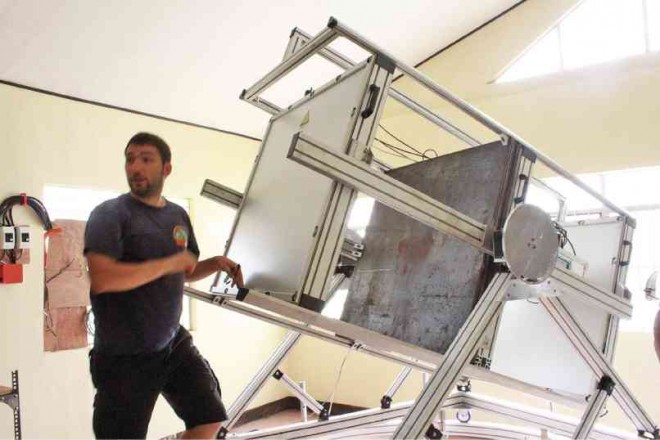Odd telescope explores inside Mayon

DR. BENOIT TAISNE, geophysicist from the Earth Observatory of Singapore, explains how the odd instrument called Muon Telescope receives and processes data using the bombardment of cosmic particles to determine the density of materials inside the Mayon Volcano 800 meters above sea level and 2,400 meters high. JUAN ESCANDOR JR.
A telescope without lens but detects the ever-changing composition of a volcano’s innards is now installed at the Mt. Mayon observatory in Tabaco City in Albay province.
One of only seven in the world, the Muon Telescope, as it is called, records changes in the density of gas, liquid magma and rock materials inside the Mayon Volcano by detecting the speed of the cosmic particles or muons as they pass through it, according to Dr. Benoit Taisne, a geophysicist from the Earth Observatory of Singapore (EOS).
Taisne is one of the builders of the Muon Telescope now commissioned to the Philippine Institute of Volcanology and Seismology (Phivolcs) and installed at the Mayon Observatory, 800 meters above sea level.
“What we are looking at are cosmic particles that go through the volcano and through the wall,” Taisne explained to reporters on June 28, while showing an odd instrument with a revolving platform and mounted with three layers of panels attached to a computer and directed toward the volcano.
Two other Muon Telecopes were deployed in Italy, two in Japan and one in France. Two will be installed in Montserrat in the Caribbean.
Article continues after this advertisementLike X-ray machine
Article continues after this advertisementThe instrument is akin to an X-ray machine, providing a picture of what is inside the volcano. It has three panels or sensors that receive the signals of cosmic particles from the volcano.
The panels also filter other cosmic particles like electrons, which are immediately eliminated because these are heavier than muons, so that the density of materials inside the volcano can be estimated precisely, Taisne explained.
He said the sensors “are sensitive to the mass so if you have magma coming up and accumulating inside the volcano then you will be able to detect that which will be reflected by the volume through the change in density.”
Since the Muon Telescope is 800 meters above sea level and oriented toward the upper portion of the 2,400-meter Mayon, it cannot determine data regarding the magma beneath the surface of the volcano, Taisne said.
The computer records and processes the data every 10 minutes, stores them into a vault, and then transmits them through the Internet for evaluation.
Solar-powered
The Muon Telescope is independently powered by a solar panel installed on the rooftop of the observatory.
Phivolcs director Renato Solidum Jr., who was in the same visit to the Mayon Observatory, said Mayon is “one of the most instrumented volcanoes with different types and modern instruments,” not only in the Philippines but among the volcanoes in many parts of the world.
Solidum said that with this capacity to monitor Mayon, his agency hoped to detect possible larger explosions and share this information with organizations and agencies involved in monitoring volcanoes and the local government units.
Phivolcs also maintains an observatory on Ligñon Hill in Legazpi City, also in Albay, which faces Mt. Mayon. This observatory, built in 1989, serves as the central monitoring station, as well as a geosciences resource center for visitors and the local community.
It has instruments that measure seismic events, gas and steam flux, water chemistry, ground deformation and tilt, and monitor visual indicators of the volcano.